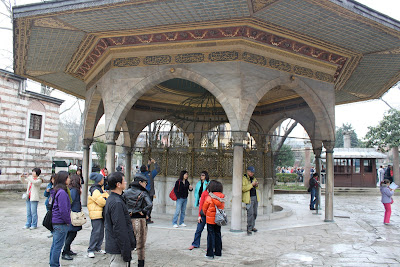Yes, weeks ago we went to Istanbul and I was so ambitious about all of the great food we ate there that I posted a long bit about the culinary experience we encountered there. Now, I have finally come to recapping the sights we saw.....and what sights they were! The city is steeped in history and culture. We were lucky enough to hire a private guide for a few days so we could see all of the main sights while asking as many questions about each place as we wanted. Plus, I enjoy spending time with a local guide just to learn about the local culture....and of course the best places to eat while in town!
Our first stop was the Blue Mosque. The Sultan Ahmet Mosque is known as the Blue Mosque because of the twenty thousand blue tiles that decorate its ceiling and inside the building. The tiles were made specially in Iznik in northern Turkey. The building of this mosque was started by Sultan Ahmet I when he was 19 years old and it took 7 years to complete.

The Blue Mosque.

First, we queued at the mosque to obtain a plastic bag at the entrance so we could remove our shoes and carry them around in such a plastic bag. No shoes allowed inside.

The mosque had laid out carpet all along the tour area/walk way so our feet were always walking on some type of tarp or carpet - never bare ground. Nifty.

Inside the blue mosque. It was beautiful and magical.



The carpet inside the blue mosque. While it is not the original carpet, our guide informed us that the tulips on the carpet design act as a signal for the amount of space in between people when praying inside the mosque during crowded prayer times. The tulips allow for people to know where they can kneel so they leave enough space for their neighbor.

Outside the blue mosque was this entrance area. This entrance has chains hanging down to remind people to bow their head, and also was used as the gate where the sultan who would be mounted on a horse to get off the horse at the entrance to the mosque.
After touring the Blue Mosque, we walked just a short distance (almost across the street - they are so close together) to Hagia Sophia. From the date of its dedication in 360 until 1453, Hagia Sophiaserved as the cathedral of Constantinople except between 1204 and 1261, when it was the cathedral of the Latin Empire. The building then became a mosque from 29 May 1453 until 1934, when it was secularized; it was opened as a museum in 1935.


































Outside in the courtyard area. Stone remains of the basilica ordered by Theodosius II, showing the Lamb of God.

Inside the beautiful architecture and domed ceilings.


These chandeliers now have light bulbs in them but when they were first used, they would have been lit by candles.

Candle light holders line the balconies throughout the church.

The loge of the Empress. From this spot, the Empress would follow and watch the divine service of the church.

Throughout the church, it is possible to see the changes made over the years from when the church was converted to mosque. When it was converted to a mosque, the large number of holy relics and many mosaics throughout the church were covered by layers of plaster and were covered with Islamic features.

Mosaic panel - The Deësis mosaic with Christ as ruler. It probably dates from 1261. It was commissioned to mark the end of 57 years of Roman Catholic use and the return to the Orthodox faith. It is widely considered the finest inside Hagia Sophia.





Coronation Square inside Hagia Sophia - it marks the supposed site of the Byzantine emperor's throne.


The wishing circle - people now line up to try to stick their thumb in a hole and rotate in a complete circle. Supposedly your wish will come true if you’re able to complete the circle....



The large doors at the exit of Hagia Sophia.

Outside Hagia Sophia, this structure with faucets were added during the time of Hagia Sophia being a mosque.
After touring Hagia Sophia we walked just a few steps to tour Topkapi Palace.

Outside the Topkapi Palace - the water

The entrance of the Imperial Gate to enter the courtyards of Topkapi Palace. The Topkapi Palace was the official and primary residence in the city of the Ottoman Sultans for 400 years of their 624-year reign from 1465 to 1856. The sultan would enter the palace through the Imperial Gate.

Cats, cats, cats everywhere throughout Istanbul....including the many courtyards of the palace. The palace is a complex made up of four main courtyards and many smaller buildings. At the height of its existence as a royal residence, the palace was home to as many as 4,000 people,

At the large Gate of Salutation, also known as the Middle Gate which leads into the palace and the Second Courtyard.

The Imperial Council building. This chamber is where the ministers of state, council ministers, the Imperial Council, consisting of the Grand Vizier, viziers, and other leading officials of the Ottoman state, held meetings.

Inside the first chamber where the Imperial Council held its deliberations.

The second chamber was occupied by the secretarial staff of the Imperial Divan.

The ceilings throughout the palace were lavish and showcased lots of gold.



The views from inside the palace walls looking out over the water.

Inside the Circumcision Room of the palace. Its interior and exterior are decorated with a mixed collection of rare recycled tiles such as the blue tiles with flower motifs at the exterior. The most important of these are the blue and white tile panels influenced by far-eastern ceramics on the chamber facade, dated 1529.


Pavilion for breaking fast. The Sultan is reported to have had the custom to break his fast under this bower during the month of Ramadan.

Inside the Baghdad Pavilion. The interior is an example of an ideal Ottoman room. With its tiles dating to the 17th century, mother-of-pearl, tortoise-shell decorated cupboard and window panels, this pavilion is one of the last examples of the classical palace architecture.

 During our sightseeing in Istanbul, we also visited the Basilica Cistern which is the largest of several hundred ancient cisterns that lie beneath the city. The cistern is very close to Hagia Sophia and was built in the 6th century during the reign of Byzantine Emperor Justinian I.
During our sightseeing in Istanbul, we also visited the Basilica Cistern which is the largest of several hundred ancient cisterns that lie beneath the city. The cistern is very close to Hagia Sophia and was built in the 6th century during the reign of Byzantine Emperor Justinian I.
Lots of columns with water throughout the bottom of the huge cellar - fish even were swimming in the water below.

In the corner of the cistern, the bases of two columns reuse blocks carved with the visage of Medusa. The origin of the two heads is unknown, though it is thought that the heads were brought to the cistern after being removed from a building of the late Roman period. Tradition has it that the blocks are oriented sideways and inverted in order to negate the power of the Gorgons' gaze.
The Hippodrome features three ancient columns. The most famous of the them is the Egyptian Obelisk, which is exactly what its name suggests - an obelisk that was imported from Egypt. Other sights are worth noting in the area too.










One afternoon, we took a cruise from Europe to Asia and back....litterally. Istanbul is partially located in Europe, and part is in Asia. We flew into the Asia side, but stayed on the Europe side. Crazy. So, we took a boat cruise along the Bosphorus and we boarded the boat in Europe, near the new mosque area - and then cruised all the way over to Asia....and then back to Europe!

















The newest feature at the Hippodrome site was a gift marking the second visit of Germany's Kaiser Wilhelm to Turkey and Sultan Abdulhamid II in 1898. It was constructed in parts in Germany and shipped to Turkey for assembly and features an octagonal dome covered in mosaics supported by eight marble columns. It occupies the approximate site of the Byzantine Emperor's seats.

A side fountain on the dome.

The Serpentine Column is one of the longest surviving relics of Greek antiquity, dating to 479BC. It honored Apollo for his aid in defeating the Persian invaders of Xerxes I at the battle of Plataea which effectively ended Persia's campaign to subjugate the Greek city-states.

The Egyptian Obelisk - Hippodrome area.

Istanbul's stock market. This was amusing to see and hear...it is basically a number of men crammed into a very small alley shouting at one another while drinking tea and trying to trade commodaties. Not quite the NYSE!

Taskim Square busy during the day with pedestrians.


The cable car running down the middle of the street. The scene reminded me of San Francisco a bit.
The nine story Galta Tower. It was Istanbul's tallest building when built in 1348.
Outside the new mosque, ladies sat in their red ticket "booths" and they sold bird seed so people could feed the massive number of pigeons already stationed around this area....
The lady with her stacks of bird seed containers for sale.

One afternoon, we took a cruise from Europe to Asia and back....litterally. Istanbul is partially located in Europe, and part is in Asia. We flew into the Asia side, but stayed on the Europe side. Crazy. So, we took a boat cruise along the Bosphorus and we boarded the boat in Europe, near the new mosque area - and then cruised all the way over to Asia....and then back to Europe!








Beautiful expensive waterfront homes.

Scott enjoyed the boat ride.

The city as seen re-approaching the old town area.


Hagia Sophia at night with the colorful fountains lit up in the courtyard area.

Carpet stores throughout the city at lots of carpet shops.
The views from our hotel were fabulous - as seen from our roof top terrace:

Hagia Sofia.

Here we are with the Bosphorus in the background.

And on another side, the Blue Mosque.







No comments:
Post a Comment